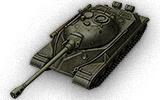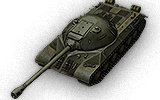Comparing: IS-5 (Object 730) vs. IS-3A

The development of the vehicle was started in 1949 by the Design Bureau of the Chelyabinsk Kirov Plant under the supervision of Joseph Kotin. In 1950 a preproduction batch of 10 vehicles was launched. After the vehicle underwent all trials and received upgrades, it was adopted for service in 1953 under the designation IS-8. |

In 1956–1957, the Military Armored Forces Academy developed a speculative design for a new loading system on the IS-3 and T-10 heavy tanks. The IS-3 variant featured a double-row ammo rack with an automatic loading system. The crew was reduced to three members: commander, gunner, and driver. The turret was redesigned in order to accommodate the loading mechanism. The vehicle existed only in blueprints. |
||
| Modules | |||
| Auto select |
|
|
|
|---|---|---|---|
| Turrets | |||
| Guns | |||
| Engines | |||
| Suspensions | |||
| Radios | |||
| Main Characteristics | |||
| Tank data page | Tank data page | Tank data page | |
| Tier | VIII | VIII | |
| Battle Tiers | 8 9 10 | 8 9 10 | |
| Price | 12,000 | 12,190 | |
| Hit Points | |||
| Signal range | |||
| Speed Limit | 42 km/h | 40 km/h | |
| Speed Limit Back | 14 km/h | 15 km/h | |
| Weight | |||
| Load limit | |||
| Crew |
|
|
|
| Armor | |||
| Hull Armor |
|
|
|
| Turret Armor | |||
|
|
|||
| Mobility | |||
| Engine Power | |||
| Horse power / weight | |||
| Traverse Speed | |||
| Max Climb Angle | |||
| Hard terrain resistance | |||
| Medium terrain resistance | |||
| Soft terrain resistance | |||
| Fire Chance | |||
| Engine Type | |||
| Turret | |||
| View Range | |||
| Turret Traverse | |||
| Traverse Arc | |||
| Armament | |||
| Damage (Explosion radius) | |||
| Penetration | |||
| Shell Price | |||
| Shell Speed | |||
| Damage / min | |||
| Rate of Fire | |||
| Reload time | |||
| Clip | |||
| Accuracy | |||
| Aim time | |||
| Elevation Arc | |||
| Ammo Capacity | |||
| Camo value | |||
| Stationary | % | % | |
| In motion | % | % | |
| When Firing | % | % | |
| Battle performance | |||
| Accuracy | % | % | |
| Neto Credits Income | |||
| Winrate | % | % | |
| Damage dealt | |||
| Kills per Battle | |||
| More stats @ vbaddict.net | More stats | More stats | |